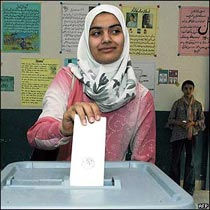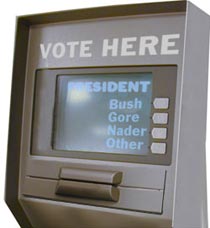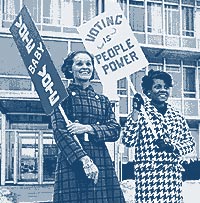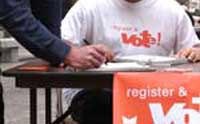| (insert your NIE or newspaper logo here) |
Weekly Online LessonOnline Lesson ArchiveGrade Level: 6-10
|
The Process of Democracy
 History was made in Afghanistan on Saturday, October 9, 2004, when about 10 million voters cast their ballots in the nation's first open elections.
History was made in Afghanistan on Saturday, October 9, 2004, when about 10 million voters cast their ballots in the nation's first open elections.
The Free and Fair Elections Foundation of Afghanistan (FEFA), the single largest group watching over the elections, ruled the polls were "fairly democratic".
Turnout was better and more peaceful than expected, in this country torn apart by two decades of war and turmoil.
Unfortunately, the democratic process was marred by an ink problem. Every voter got his or her thumb marked by what was supposed to be indelible, or permanent, ink. During election day, it was discovered that this ink could be easily washed off, meaning that it might be possible for a citizen to cast more than one vote.
The wrong ink was generally replaced with the right stuff by the time polls closed, but the damage to the election's credibility was already done. By the end of the day, 15 of the 18 presidential candidates called for a boycott and demanded new elections.
 United Nations and Afghan officials overseeing the elections ruled there was no need for a new vote, but promised that every complaint would be investigated.
United Nations and Afghan officials overseeing the elections ruled there was no need for a new vote, but promised that every complaint would be investigated.
Since then, many who called for a new election have agreed to settle with whatever the official investigators conclude.
At about the time that those officials finish counting Afghan ballots and investigating possible fraud -- in two to three weeks, they estimate -- American voters will cast their own ballots to decide who will preside over the United States for the next four years.
U.S. elections are different from the one held in Afghanistan in a number of ways. For example, Americans use valid IDs and signatures rather than blackened thumbs to enforce the one-person-one-vote rule, the voting systems are typically more high-tech with a lower risk for fraud, and presidential winners are ultimately determined by electoral votes rather than popular votes.
In this week's lesson, you'll learn about how ballots are cast and counted in the American election process, and how that has changed over the years. You'll also discover how the Electoral College comes into play, and why "swing states" are important for presidential candidates to win over.
The Machinery of Democracy
 Taking a vote in a small group with a show of hands is pretty quick and easy. Now compare that with recording millions of ballots -- fairly and anonymously -- for voters spread across 3.8 million square miles. Who wants that headache?
Taking a vote in a small group with a show of hands is pretty quick and easy. Now compare that with recording millions of ballots -- fairly and anonymously -- for voters spread across 3.8 million square miles. Who wants that headache?
Fortunately, many people have chosen to help make the American voting process as easy and accurate as possible over the years. While any system will always include some degree of error, better technology and voter education has generally improved the process.
Let's see how this process evolved by looking closer at VOTE: The Machinery of Democracy, produced by the National Museum of American History.
From the home page, you can choose to browse the site's webpages using the numbered menu at the top or you can Launch the Flash Interactive Exhibit.
Click 1/Introduction or Continue to begin, and continue through America's Voting Patchwork and the use of Paper Ballots.
How did the term "ballot" originate? Who controlled the printing and distribution of paper ballots through most of the 19th century? What year was the Electoral College established?
 Now, find out how The Acme of Reform changed the political control over the voting process. In what ways did these reforms help to curb fraud?
Now, find out how The Acme of Reform changed the political control over the voting process. In what ways did these reforms help to curb fraud?
Next, take a closer look at two of the primary voting machines used by Americans over the years -- The Gear & Lever Voting Machine and the Punch Card Democracy, including the controversy in Florida 2000.
How does counting the votes in gear and lever machines compare to punch cards? For each method, where does the greatest risk of human error lie? In which states were women first allowed to vote? What was the significance of the Voting Rights Act? What happened in 1971 that instantly boosted the number of eligible voters by about 11 million?
As you'll discover in Design for Democracy and The Present and Future Ballot, officials tried to better inform and instruct voters at the polls, and were directed by the Help America Vote Act to phase out older voting machines. What are some ways that the newer voting machines and methods may also be at risk for errors or fraud? Can you think of any other methods that could work better?
The Electoral College
 As noted earlier in the lesson, the American President is chosen by electoral rather than popular votes. If this were not the case, most experts agree, then Al Gore would have become president in 2000, not George W. Bush.
As noted earlier in the lesson, the American President is chosen by electoral rather than popular votes. If this were not the case, most experts agree, then Al Gore would have become president in 2000, not George W. Bush.
To understand How the Electoral College Works, let's take a trip over to the HowStuffWorks site.
After reading the introduction, learn about how the Electoral College was The Founding Fathers' Idea. How many electoral votes does each state get? Why would this system be controversial?
As you'll soon discover, American history notes four instances When the Electoral College Counted and how that compares to The Present View.
How many times did the House of Representatives decide who would be president? Do you think that the Electoral College system makes sense? Why or why not?
After the 2000 election, Americans began to better understand how the casting and counting of popular votes, along with the power of electoral votes, influenced the results. Presidential candidates in 2004 face this reality every day, and know that it's imperative for them to know How the Swing States Work.
 Begin your own study of the "swing state" dilemma by reading the introduction, reviewing the Electoral College, then analyzing The States and Their Leanings. How does each state's voting history determine whether it's a swing or safe state? Do you live in a swing state? If not, what party typically dominates the state's electoral votes?
Begin your own study of the "swing state" dilemma by reading the introduction, reviewing the Electoral College, then analyzing The States and Their Leanings. How does each state's voting history determine whether it's a swing or safe state? Do you live in a swing state? If not, what party typically dominates the state's electoral votes?
Now find out how this influences where politicians spend most of their time on The Campaign Trail. What are the two main reasons for a candidate to visit one state over another? Which two states seem to be the most critical to win in the 2004 election?
Lastly, check out the map that illustrates What Happened in 2000, and rollover each state for details. What percentage of eligible voters actually cast ballots that year? Did the popular votes match the electoral votes for each state?
Newspaper Activities
Browse current issues of Targetnewspaper, looking for articles about the elections in either Afghanistan or the United States. In what ways are officials trying to strengthen the voting process -- including voter education, better voting machines, improved counting methods, etc. -- to make it as fair and accurate as possible? What problems are being resolved? What types of voting machines does your county plan to use? How will the popular votes ultimately be tallied? Are people worried about the risks of error or fraud? In what ways are presidential candidates attempting to sway swing states? For example, trace which cities they visit for speaking engagements. Are candidates addressing issues that seem the most important to that particular region?
© Copyright 2004
Learners
Online,
Inc.
